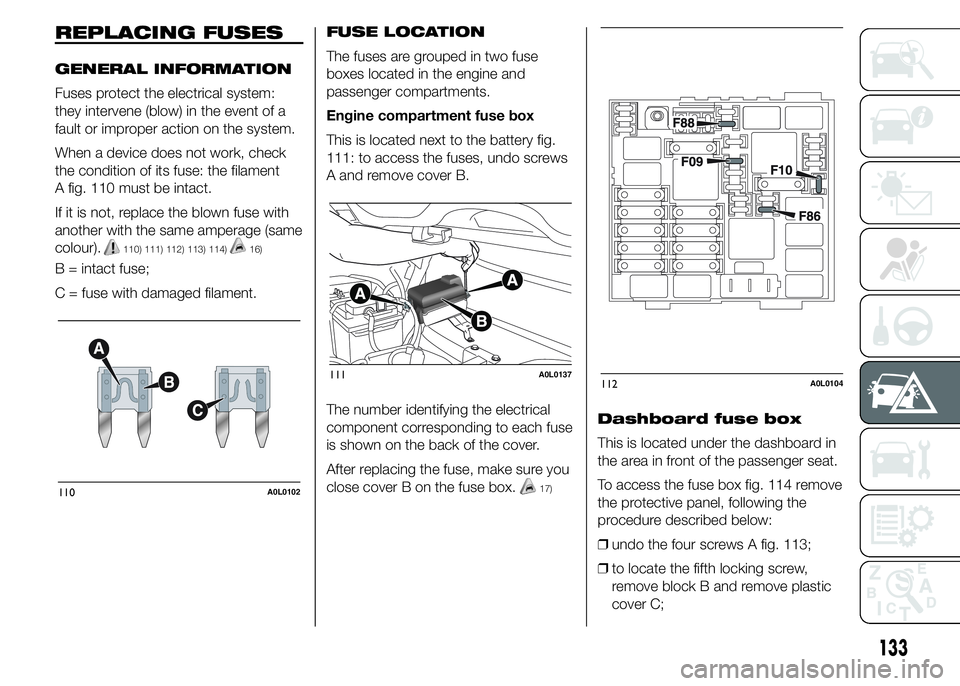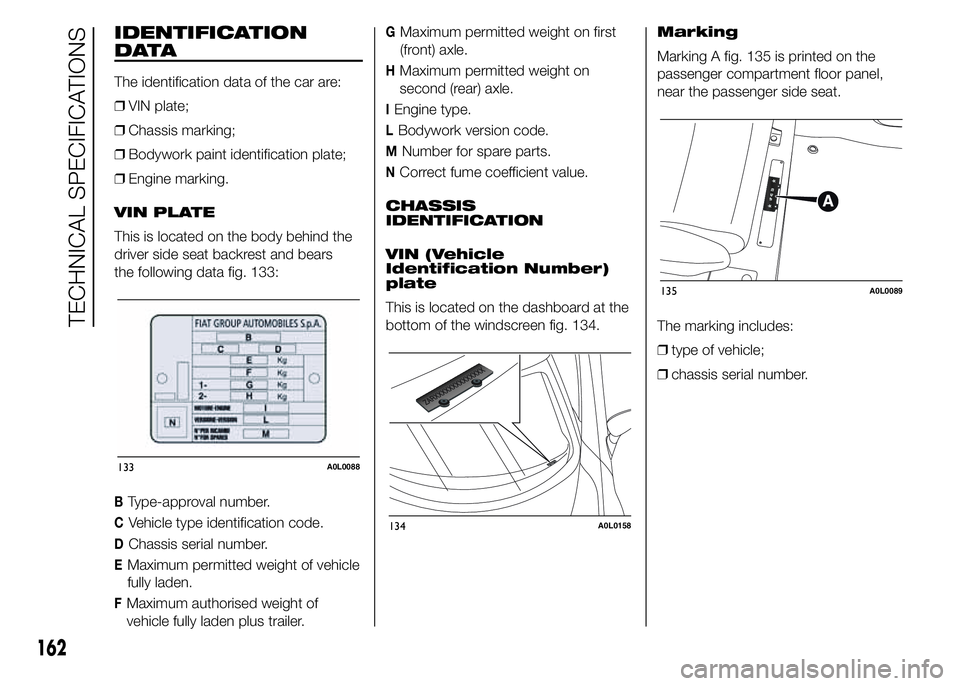dashboard Alfa Romeo 4C 2015 Owner handbook (in English)
[x] Cancel search | Manufacturer: ALFA ROMEO, Model Year: 2015, Model line: 4C, Model: Alfa Romeo 4C 2015Pages: 199, PDF Size: 7.67 MB
Page 103 of 199

Main safety rules to be
followed when carrying
children
ŌØÆFollow the instructions supplied with
the child restraint system itself, which
the manufacturer must provide.
Keep the instructions in the car along
with the other documents and this
handbook. Do not use child restraint
systems without instructions;
ŌØÆalways check that the seat belt is well
fastened by pulling on it;
ŌØÆonly one child is to be strapped into
each restraint system; never carry
two children using one child restraint
system;
ŌØÆalways check that seat belts do not
rest on the childŌĆÖs neck;
ŌØÆwhile travelling, do not let the child sit
incorrectly or release the belts;
ŌØÆnever carry children on your lap, even
newborns. No-one could restrain
them in the event of an accident;
ŌØÆin the event of an accident, replace
the child restraint system with a
new one.FRONT AIRBAGS
DRIVER AND
PASSENGER FRONT
AIRBAGS
The car features multistage front
airbags (ŌĆ£Smart bag systemŌĆØ) for driver
and passenger.
The front driver/passenger airbags are
designed to protect occupants in the
event of frontal impacts of medium-high
severity, by placing the bag between
the occupant and the steering wheel or
dashboard.
Therefore, non-activation of the front
airbags in other types of collisions (side
collisions, rear shunts, rollovers, etc.)
does not indicate a system malfunction.
Airbags are not a replacement of but
complementary to the seat belts, which
you are recommended to always wear.
In the event of impact, those not
wearing a seat belt are projected
forwards and may come into contact
with the bag which is still inflating. The
protection offered by the bag is
compromised in these circumstances.
72)
Front airbags may not activate in the
following situations:ŌØÆfrontal impacts against highly
deformable objects not involving the
front surface of the car (e.g. wing
collision against guard rail);
ŌØÆjamming of the car underneath other
vehicles or protective barriers (e.g.
underneath a truck or a guard rail); in
this case, the bags would offer no
additional protection with respect to
the seat belt and their deployment
would be inappropriate. In these
cases, non-deployment does not
indicate a system malfunction.
Driver front airbag
This is located in a dedicated
compartment in the centre of the
steering wheel fig. 71.
73)
71A0L0055
99
Page 104 of 199

Passenger front airbag
This is located in a dedicated
compartment in the dashboard fig. 72.
74)
GENERAL WARNINGS
The front airbags may activate in the
event of sharp impacts to the
underbody of the car (e.g. impact with
steps, pavements, potholes or road
bumps, etc.).
When the airbag deploys it emits a
small amount of dust: the dust is
harmless and does not indicate the
beginning of a fire. The dust may irritate
the skin and eyes however: in this
case, wash with neutral soap
and water.
Airbag checking, repair and
replacement must be carried out at a
dedicated Alfa Romeo Dealership.If the car is scrapped, have the airbag
system deactivated at a dedicated
Alfa Romeo Dealership.
Pretensioners and airbags are deployed
according to different logics on the
basis of the type of collision. Failure to
deploy of one of the devices does
not necessarily indicate a system
malfunction.
77) 78) 79) 80) 81) 82) 83)
WARNING
72) Do not apply stickers or other
objects to the steering wheel or
the passenger side airbag cover.
Do not place objects on the
passenger side of the dashboard
because these could interfere
with the correct opening of the
passenger airbag and cause injury
to occupants.
73) Always drive keeping your hands
on the steering wheel rim so that
the airbag can inflate freely if
necessary. Do not drive with your
body bent forward. Keep the
backrest in straight position,
resting correctly your back on it.74) Instructions to deactivate the
passenger's front airbag can be
found in the "Menu Options"
paragraph of the "Knowing the
instrument panel" chapter. Please
note that under these conditions
the airbag will NOT deploy in case
of need (accident).
75) Do not rest your head, arms or
elbows on the door to prevent
injury during airbag deployment.
76) Never lean your head, arms and
elbows out of the window.
77) If the
warning light does not
switch on when the key is turned
to MAR-ON, or stays on while
driving (on some versions
together with a message on the
display) there may be a fault in the
restraint systems. In this case,
airbags or pretensioners may not
be activated in the case of an
accident or (in a lesser number of
cases) they may be activated
incorrectly. Before proceeding,
contact a dedicated Alfa Romeo
Dealership to have the system
checked immediately.
78) Do not travel carrying objects on
your lap, in front of your chest or
between your lips (pipe, pencils,
etc.): they could cause severe
injury if the airbag is deployed.
72A0L0056
100
SAFETY
Page 123 of 199

REPAIRING A WHEEL
GENERAL
INSTRUCTIONS
The car is equipped with a quick tyre
repair device called the "Fix&Go
automatic" kit.
92) 94)
To use it, follow the instructions below.
93) 95) 96)13)2)
"Fix&Go automatic" KIT
It is located in the luggage
compartment.
The kit includes:
ŌØÆbottle A fig. 80 containing sealant
and fitted with: filling tube B and
adhesive label C with the wording
ŌĆ£max. 80 km/hŌĆØ to be placed in
a clearly visible position (e.g. on the
dashboard) after repairing the tyre;
ŌØÆcompressor D complete with
pressure gauge and connectors;
ŌØÆan information leaflet fig. 81,
providing instructions for using the kit
correctly. This booklet should be
given to the persons charged with
handling the tyre treated with this kit;
ŌØÆa pair of gloves located in the side
compartment of the compressor;
ŌØÆadaptors for inflating different
elements.IMPORTANT The sealant is suitable for
use at temperatures in the range from
ŌłÆ20┬░C to +50┬░C. The sealant has an
expiry date.INFLATION PROCEDURE
Proceed as follows:
97)
ŌØÆengage the handbrake, unscrew the
tyre valve cap, take out filler hose A
fig. 82 and tighten ring nut B on
the tyre valve;
ŌØÆmake sure that switch A fig. 83 for
the compressor is in position 0 (off),
start the engine, insert the plug
into the cigar lighter socket on the
central tunnel (see fig. 84) and switch
on the compressor by bringing
switch A fig. 83 to I (on);
ŌØÆinflate the tyre to the pressure
indicated in the ŌĆ£WheelsŌĆØ paragraph
in the ŌĆ£Technical dataŌĆØ chapter. In
order to obtain a more precise
reading, check the pressure value on
pressure gauge B fig. 83 with the
compressor off;
80A0L0076
81A0L0077
82A0L0078
119
Page 137 of 199

REPLACING FUSES
GENERAL INFORMATION
Fuses protect the electrical system:
they intervene (blow) in the event of a
fault or improper action on the system.
When a device does not work, check
the condition of its fuse: the filament
A fig. 110 must be intact.
If it is not, replace the blown fuse with
another with the same amperage (same
colour).
110) 111) 112) 113) 114)16)
B = intact fuse;
C = fuse with damaged filament.FUSE LOCATION
The fuses are grouped in two fuse
boxes located in the engine and
passenger compartments.
Engine compartment fuse box
This is located next to the battery fig.
111: to access the fuses, undo screws
A and remove cover B.
The number identifying the electrical
component corresponding to each fuse
is shown on the back of the cover.
After replacing the fuse, make sure you
close cover B on the fuse box.
17)
Dashboard fuse box
This is located under the dashboard in
the area in front of the passenger seat.
To access the fuse box fig. 114 remove
the protective panel, following the
procedure described below:
ŌØÆundo the four screws A fig. 113;
ŌØÆto locate the fifth locking screw,
remove block B and remove plastic
cover C;
110A0L0102
111A0L0137112A0L0104
133
Page 139 of 199

ENGINE COMPARTMENT FUSE BOX
fig. 112
DEVICE PROTECTED FUSE AMPERE
Headlight beam switch (for versions/markets, where provided) F09 5
Single tone hornF10 10
12 V socket / cigar lighter F86 15
External mirror defrosters F88 7.5
.
DASHBOARD FUSE BOX
fig. 114
DEVICE PROTECTED FUSE AMPERE
Central lockingF38 15
Two-way windscreen washer pump F43 20
+30 Driver side electric windows F47 20
+30 Passenger side electric windows F48 20
135
Page 166 of 199

IDENTIFICATION
DATA
The identification data of the car are:
ŌØÆVIN plate;
ŌØÆChassis marking;
ŌØÆBodywork paint identification plate;
ŌØÆEngine marking.
VIN PLATE
This is located on the body behind the
driver side seat backrest and bears
the following data fig. 133:
BType-approval number.
CVehicle type identification code.
DChassis serial number.
EMaximum permitted weight of vehicle
fully laden.
FMaximum authorised weight of
vehicle fully laden plus trailer.
GMaximum permitted weight on first
(front) axle.
HMaximum permitted weight on
second (rear) axle.
IEngine type.
LBodywork version code.
MNumber for spare parts.
NCorrect fume coefficient value.
CHASSIS
IDENTIFICATION
VIN (Vehicle
Identification Number)
plate
This is located on the dashboard at the
bottom of the windscreen fig. 134.Marking
Marking A fig. 135 is printed on the
passenger compartment floor panel,
near the passenger side seat.
The marking includes:
ŌØÆtype of vehicle;
ŌØÆchassis serial number.
133A0L0088
134A0L0158
135A0L0089
162
TECHNICAL SPECIFICATIONS